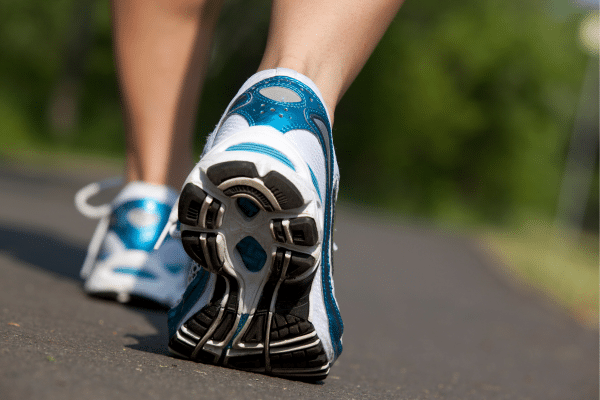Walking is a simple, yet powerful, tool in the journey towards weight loss and better health. It’s an activity that requires minimal equipment and can be tailored to fit any fitness level. Walking not only burns calories but also improves cardiovascular health, strengthens bones, and boosts mood. The beauty of walking lies in its versatility – it can be done anywhere, anytime, and by almost anyone. This post delves into effective strategies for utilizing walking as a key component in a weight loss journey, offering practical tips and insights to help readers achieve their fitness goals.
Contents
- 1 Understanding The Basics Of Walking For Weight Loss
- 2 Setting Realistic Goals And Expectations
- 3 The Right Gear: Shoes And Attire
- 4 Integrating Walking Into Your Daily Routine
- 5 Enhancing Your Walk: Speed, Incline, And Technique
- 6 Tracking Progress: Apps And Pedometers
- 7 Nutrition And Hydration For Walking
- 8 Overcoming Challenges And Staying Motivated
- 9 The Bottom Line
Understanding The Basics Of Walking For Weight Loss

Walking for weight loss is grounded in the basic principle of energy expenditure. By walking, the body burns calories, which, when combined with a calorie-controlled diet, leads to weight loss. The number of calories burned depends on several factors, including walking speed, duration, and the individual’s weight. For instance, a brisk walk can burn more calories than a leisurely stroll. Additionally, walking uphill or on an incline increases calorie burn. It’s important to understand that weight loss from walking is a gradual process and results will vary based on individual effort and consistency.
Another key aspect of walking for weight loss is the role of metabolism. Regular walking can increase metabolic rate, helping the body to burn calories more efficiently even when at rest. It’s also beneficial for maintaining lean muscle mass, which is crucial for a healthy metabolism. This form of exercise is particularly appealing because it’s low-impact, reducing the risk of injury compared to high-intensity workouts. Furthermore, walking has the added advantage of being easily integrated into daily life, making it a sustainable form of exercise for long-term weight management.
Setting Realistic Goals And Expectations

To effectively lose weight through walking, setting achievable goals is essential. These goals can be based on distance, duration, or the number of steps taken daily. For example, a beginner might start with a goal of walking 10,000 steps a day or walking for 30 minutes daily, gradually increasing the intensity and duration over time. It’s important to tailor these goals to personal fitness levels and limitations to avoid burnout and injury.
Setting realistic expectations is equally important. Weight loss is a gradual process, and it’s essential to understand that significant changes won’t happen overnight. Consistency is key. Rather than focusing solely on the scale, it’s beneficial to acknowledge other indicators of progress, such as improved stamina, better mood, and increased energy levels. Celebrating these small victories can provide motivation and reinforce the habit of walking regularly.
The Right Gear: Shoes And Attire

Choosing the right footwear is critical for a comfortable and injury-free walking experience. Shoes designed specifically for walking or running offer the necessary support and cushioning. It’s important to select shoes that fit well and are appropriate for the individual’s foot type and walking style. Ill-fitting shoes can lead to discomfort and injuries, hindering the consistency of a walking routine.
Selecting appropriate attire is also important for walking, especially considering varying weather conditions. Lightweight, breathable fabrics are ideal for warm weather to help regulate body temperature and prevent overheating. In colder climates, layers are key to maintaining warmth without restricting movement. Reflective clothing or accessories are advisable for those who walk early in the morning or late in the evening, ensuring visibility and safety. Comfort and practicality in clothing choice can significantly enhance the walking experience.
Integrating Walking Into Your Daily Routine

Incorporating more walking into daily life can significantly contribute to weight loss. Simple changes, such as choosing stairs over elevators, parking further from the destination, or taking short walking breaks during the day, can increase daily step count. Even for those with busy schedules, these small adjustments can make a big difference. Walking can also be integrated into social activities, such as meeting friends for a walk instead of sitting in a café, which adds an enjoyable and social element to exercise.
Making walking a daily habit requires creativity and commitment. Setting reminders to take walking breaks, planning walking routes in advance, or having a set time each day dedicated to walking helps in establishing this habit. For families, incorporating walks into family time can be both beneficial for health and bonding. For office workers, walking meetings or lunchtime walks are effective ways to fit exercise into a hectic schedule. The key is finding opportunities to walk more within the context of one’s lifestyle.
Enhancing Your Walk: Speed, Incline, And Technique

To maximize weight loss benefits, enhancing the walking routine is crucial. Increasing the speed of walks, incorporating intervals of brisk walking, or choosing routes with inclines can boost the intensity of workouts. This not only burns more calories but also builds endurance and strength. Paying attention to posture and stride while walking can further enhance the effectiveness of the exercise, ensuring a full range of motion and reducing the risk of injury.
Proper walking technique involves maintaining a straight posture, swinging arms naturally, and walking heel to toe. This technique ensures maximum engagement of muscles and promotes better breathing, making the walk more effective. For those looking to challenge themselves, adding ankle or wrist weights can increase resistance, providing an additional level of difficulty to their walking routine. It’s important, however, to increase intensity gradually to prevent strain or injury.
Tracking Progress: Apps And Pedometers

Utilizing technology such as fitness apps and pedometers can be a game-changer in tracking walking progress. These tools provide valuable insights into the number of steps taken, distance covered, and calories burned. By setting daily or weekly goals in these apps, one can stay motivated and monitor improvements over time. Many apps also offer features like route mapping and social sharing, adding an extra layer of engagement to the walking routine.
The motivational aspect of tracking progress cannot be overstated. Seeing tangible data on improvements can be incredibly rewarding and encouraging. Some people find it helpful to join online challenges or communities through these apps, which adds a competitive and social element to walking. This sense of community and shared goals can be a powerful motivator in maintaining a consistent walking regimen.
Nutrition And Hydration For Walking

Balancing nutrition with a walking regimen is essential for optimal weight loss results. Eating a diet rich in whole foods, lean proteins, fruits, vegetables, and whole grains provides the necessary energy for walking. Avoiding processed foods and high-sugar snacks helps in managing calorie intake and maintaining steady energy levels. It’s not just about eating less, but eating right, to fuel the body effectively for exercise.
Staying hydrated is equally important, especially for those walking long distances or in warm weather. Dehydration can lead to fatigue and decreased performance, so drinking water before, during, and after walking is crucial. For longer walks, carrying a water bottle is advisable. Additionally, post-walk meals should include a balance of carbohydrates and protein to aid in muscle recovery and replenishment of energy stores.
Overcoming Challenges And Staying Motivated

Walking regularly can sometimes be challenging due to factors like boredom, bad weather, or a busy schedule. Overcoming these challenges is key to maintaining a consistent walking routine. Finding new and interesting routes, listening to music or podcasts while walking, or varying the walking routine can help keep things interesting. Indoor walking workouts or treadmill walks are alternatives for bad weather days.
Staying motivated can also be challenging, especially when results are slow to manifest. Setting small, achievable milestones and rewarding oneself upon reaching them can help maintain motivation. Joining walking groups or finding a walking buddy provides social encouragement and accountability. Remember, the journey to weight loss is a marathon, not a sprint, and persistence is vital.
The Bottom Line
Walking is an accessible, effective, and versatile way to aid in weight loss and improve overall health. It’s not just about the physical act of walking, but also about integrating it into daily life, enhancing the routine for better results, tracking progress, balancing nutrition, and overcoming challenges. By adopting these strategies, walking can become an enjoyable and sustainable part of a healthier lifestyle. The key takeaway is that with dedication and the right approach, walking can be a powerful tool in achieving weight loss goals.


